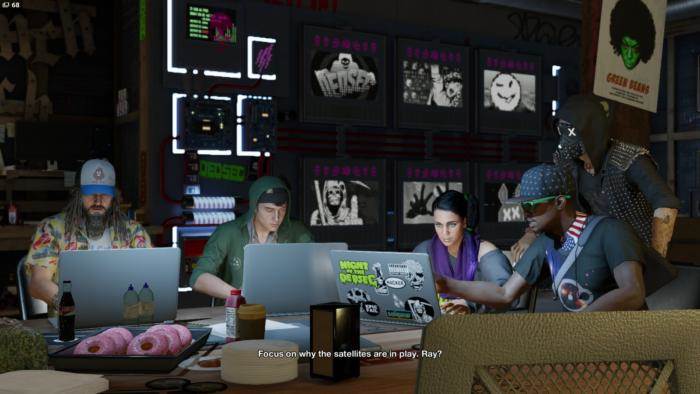Bear with me for a bit. I’m going to get around to Watch Dogs 2, but it’s going to be by way of a semi-lengthy tangent into Assassin’s Creed—particularly, what Assassin’s Creed II meant to that now-juggernaut of a series.
It’s easy to forget, with almost a decade of sequels under our belt, that there was a time when Assassin’s Creed could’ve conceivably died off. Early on, too. After garnering quite a bit of hype, the original Assassin’s Creed released in 2007 to middling reviews. “Disappointing,” said many, or “Repetitive.” It had some great ideas, but was a boring mess of a game.
That might have been the end, but no. Assassin’s Creed II released in 2009, ushering in the “Ubisoft Formula” that propelled the publisher to new heights and then became the butt of industry jokes: 1) Climb towers 2) Unlock a million icons on the map 3) Grind out some missions 4) Repeat. Sure, it’s trite now, but at the time it marked a huge shift in the open-world genre.
One of those Assassin’s Creed II-alikes was Watch Dogs. Released in 2014 following years of hype, it adapted all the same Assassin’s Creed II tropes to the modern era, with just a dash of “hacking” on top. And it was boring as hell.
So if you’d asked me up until two weeks ago whether Watch Dogs needed a sequel, I’d have said no. Absolutely not. And yet surprise of all surprises, Watch Dogs 2 is just as big a comeback as Assassin’s Creed II. The irony? It had to burn down the Assassin’s Creed II formula in order to do it.
A twist on old tricks
Okay, maybe I’m overstating things a bit. I don’t think Watch Dogs 2 is going to mark quite the same genre-shaking shift as Assassin’s Creed II, nor is it a perfect game. There are still some dodgy bits to this tale of Marcus, San Francisco Bay Area hacker extraordinaire.

But Watch Dogs 2 takes some real meaningful steps away from the formula. The one Ubisoft publicized the most prior to release is of course “No tower climbing,” which also equates to no more tedious district reclamation and none of those overdone “Camera Pulls Way Out And Swirls Around The Landscape” scenes.
Tower climbing was an obvious target. Its inclusion in the original Watch Dogs was one of the first times we really started to see a homogenization across all of Ubisoft’s games, because “How does tower climbing fit in the story of an all-powerful hacker?” And it’s only gotten worse since. (See: The Crew.)
Obvious or not, it’s a huge shift in presentation though. The San Francisco of Watch Dogs 2 feel more like a world and less like a series of artificial hurdles to overcome. As if to bring the point home, the game’s second mission has you drive from Sausalito across the Golden Gate Bridge into San Francisco, as if to say “See! No gates here! Go wherever you want!”

And without tower climbing to rely on as a crutch, other pieces of Ubisoft’s formula start to crumble. Side missions must be introduced in a logical manner, for instance—and are. They’re couched in the world’s fiction, with Marcus hacking people’s phones or being handed missions by his friends at hacking collective Dedsec.
They’re creative, too. The Assassin’s Creed II formula was “Do the same tedious activity a dozen times, but in different parts of the city.” In Watch Dogs 2, each side mission has its own story, and often its own unique environment to explore—be it a robot assembly line or Ubisoft’s own San Francisco studio.
Even collectibles are covered within the Watch Dogs 2 fiction. “ScoutX,” for example—an app on Marcus’s phone that rewards you for seeking out and taking pictures of Bay Area landmarks. It’s like Niantic’s real-life Field Trip app mixed with Foursquare, a.k.a. an app that could conceivably exist in our actual reality. And each “collectible” is technically unique, so you’re not just grabbing your hundredth feather from a rooftop, you feel like you’re exploring the city.

The result? Instead of feeling like a straightforward story with optional side activities, as in the ol’ Ubisoft Formula, Watch Dogs 2 feels more like a non-linear narrative. You’ve got a character (Marcus) and an end-goal (overthrow the evil Blume corporation) but other than that you’re free to dabble in the story wherever you’d like. I’ve advocated for that style of open-world storytelling in the past, and while I don’t think Watch Dogs 2 makes it all the way—there’s still definitely a central thread to follow—it gets pretty damn close.
It made me want to engage. In Assassin’s Creed, I’ve long since given up on grabbing every asinine treasure chest or dumb MacGuffin on my way to the finish line. But in Watch Dogs 2, I’d often see the little “ScoutX location nearby!” tag pop up on the GPS, slam on the brakes, and jump out to take a picture on the way to my next mission.
Sure, there are still issues. The people walking down the street don’t seem particularly smarter than Assassin’s Creed’s mobs—strangle a guy in front of them and half the time they’ll forget to react. Sometimes you’ll see pedestrians act out scenes together, but then you’ll see the same scene repeated later and it loses the magic.

There are also still some scattered holdovers from the “Let’s just cram everything in” mentality. A series of race missions are the worst offenders, standard open-world fodder that we should just let die already.
Overall though it’s an impressive shift for Ubisoft. In recent years, I’ve often said that Ubisoft’s output feels more like a collection of incredible art assets than a real game—a beautiful city, in other words, brimming with some of the most vapid “content” possible. That’s not the case here. There’s more to Watch Dogs 2 than a sometimes-stunning recreation of San Francisco and the surrounding areas.
And while this upturning of the Ubisoft formula is in large parts the reason I enjoyed Watch Dogs 2, I’d feel remiss if I didn’t talk briefly about its improvements within the context of the first game: Writing a character who actually matters and making hacking a viable strategy.

The first is pretty self-explanatory. New protagonist Marcus is simply a hell of a lot more interesting than his predecessor, the Forever-Grumpy-And-Entirely-Forgettable Aiden Pearce, a character who’s only memorable (get ready for the paradox) because he’s so generic.
Watch Dogs 2 ditches the dour, cliché tale of vengeance for a lighthearted power fantasy where the hackers are party-hounds and outcasts fighting “The Man” for reasons that come straight out of a Marxist handbook. It’s pure bubblegum fluff, but at least it remembers not to take itself too seriously—for the most part. There is one embarrassing and hackneyed series of missions in Oakland mid-game, but it’s quickly abandoned and afterward Marcus and Co. are right back to stupid jokes and ridiculous slang.
As for the hacking, I’m pleased with how it’s changed in the sequel. Functionally, it’s not much different. You’re still jumping camera-to-camera, maybe distracting guards with an incoming phone call or stunning them with a jolt from a convenient electrical panel.
But where the original Watch Dogs felt like a shooter where you occasionally paused to hack something, Watch Dogs 2 makes it much more viable to ghost through entire missions unseen.

One of my favorite examples: A mission charged me with blowing up some contraband hidden in a heavily guarded garage. In most games that would mean shooting my way into the garage, putting explosives on the crates inside, blowing them up, and then jumping into a car to escape my pursuers. And sure, you could play it that way in Watch Dogs 2. Or you could hack a nearby forklift, direct it to pick up a nearby tank of fuel, drive that into the garage, and use your phone to tell it to explode—all without the guards ever realizing you’re there. Then it’s just a leisurely drive away from the scene of the crime, no pursuit, and you’re out.
Almost every mission seems to have some sort of creative path towards completion, and the possibilities open up even more once you unlock Marcus’s RC Car and Quadcopter, both of which can be used for scouting or long-range hacking while Marcus sits safely outside the mission area.
The hacking’s still completely ridiculous and unrealistic, and the guards a bit dumb—What, nobody suspects the guy using his laptop in the woods outside their heavily-guarded compound might be up to something? But it’s a much better proof-of-concept of the whole Watch Dogs idea than the original game.
Bottom line
There are missteps. The worst moment of Watch Dogs 2 is the part where Ubisoft decided to play that “If you’re going to San Francisco, be sure to wear some flowers in your hair,” song. Or maybe the part where one of the characters calls it ‘Frisco—something no native (or even short-term transplant) would ever be caught dead doing.
But you know what? I really enjoyed Watch Dogs 2. More than just a pretty backdrop for a ho-hum game, Ubisoft finally broke with its formula and put out something fresh. Even crazier is the fact that it didn’t take that much refinement—most of the key components are still here, they’re just better seated within the story instead of sitting like a layer of game-y scum on top.
Hopefully it’s the first in a new trend. Maybe we can finally put the tired old bones of Assassin’s Creed II to rest instead of trotting them out for a parade every November.







